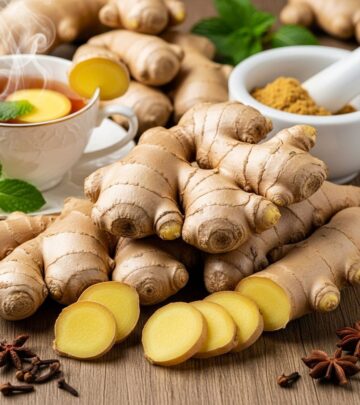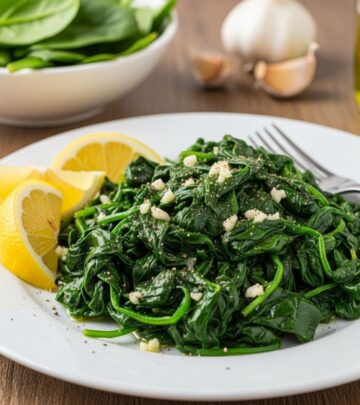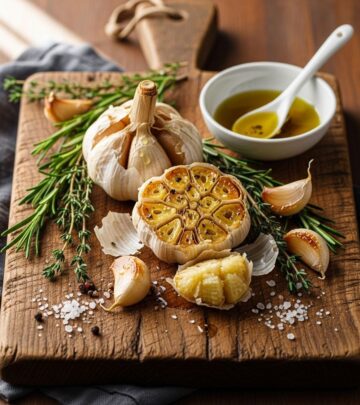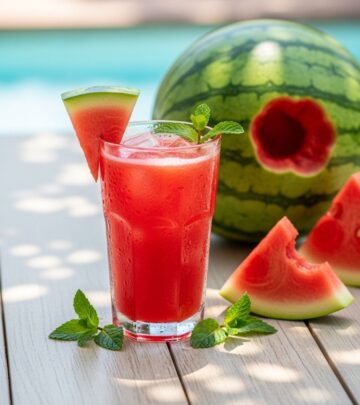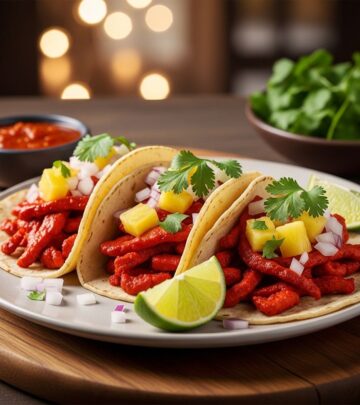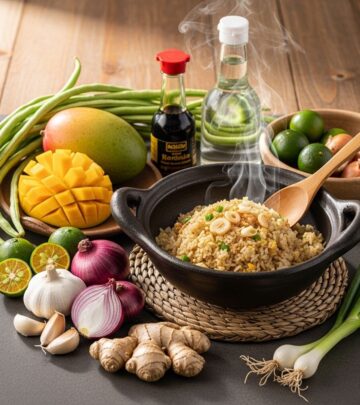Thai Basil Chicken Recipe: Easy Authentic 30-Minute Dinner
Master the art of Thai street food with this flavorful, aromatic dish you can make at home
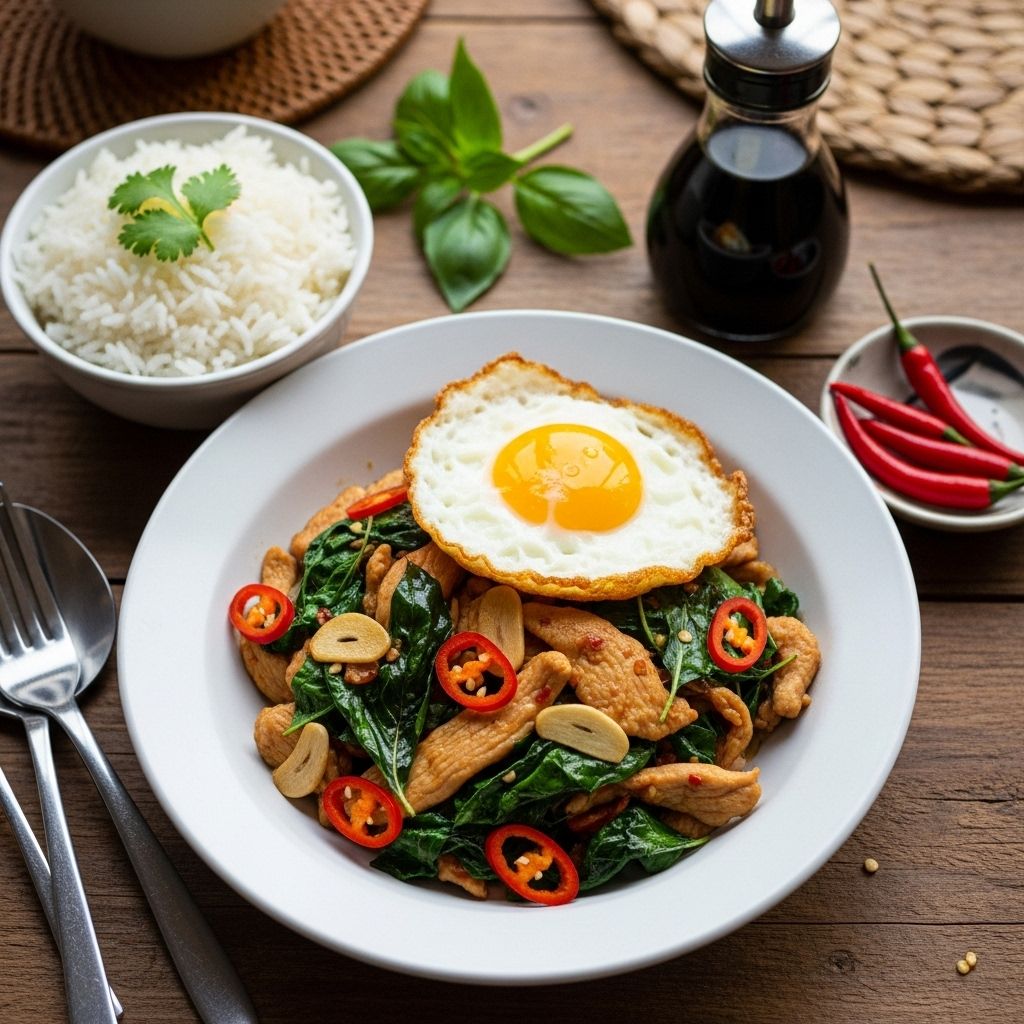
Image: HearthJunction Design Team
Introduction to Spicy Thai Basil Chicken
Thai Basil Chicken, known in Thailand as Pad Krapow Gai, is one of the most beloved dishes in Thai cuisine. This aromatic stir-fry combines the perfect balance of spicy, sweet, and savory flavors that Thai food is famous for. Despite its complex flavor profile, this dish is surprisingly simple to prepare at home, making it an excellent choice for anyone wanting to explore Thai cooking without spending hours in the kitchen.
As Chef John notes, “I don’t cook Thai food at home often, mostly because there are at least a dozen such restaurants within walking distance, but when I do, there’s nothing I enjoy more than this spicy Thai basil chicken.” This sentiment resonates with many home cooks who discover just how accessible and rewarding making this dish can be. In less than 30 minutes, you can create a restaurant-quality meal that will transport your taste buds straight to the streets of Bangkok.
What makes this recipe particularly special is its authentic approach combined with practical adaptations for the home cook. The careful balance of traditional ingredients creates layers of flavor that develop throughout the cooking process, resulting in a dish that’s both comforting and exciting. Whether you’re a seasoned cook or new to Thai cuisine, this Pad Krapow Gai recipe offers a foolproof way to bring the vibrant flavors of Thailand to your dinner table.
What Is Thai Basil Chicken?
Thai Basil Chicken (Pad Krapow Gai) is a staple in Thai cuisine that has gained international popularity for its bold flavors and aromatic qualities. At its core, this dish is a stir-fry featuring finely chopped or ground chicken cooked with chile peppers, garlic, and shallots. The mixture is seasoned with a carefully balanced sweet and salty sauce, then finished with fresh basil leaves that wilt into the hot mixture, releasing their distinctive aroma and flavor.
In Thailand, this dish is ubiquitous – found everywhere from high-end restaurants to humble street food stalls. It’s considered comfort food for many Thais, often served over a bed of jasmine rice and commonly topped with a crispy fried egg (kai dao). The runny yolk creates a rich sauce when mixed with the spicy chicken, adding another dimension to this already complex dish.
Authentically, the dish uses holy basil (bai krapow), which has a peppery, clove-like flavor that’s more intense than the sweet basil commonly found in Western supermarkets. Thai basil, with its slight anise flavor, makes an excellent substitute when holy basil isn’t available. This adaptability is part of what makes this dish so accessible to home cooks outside of Thailand.
Essential Ingredients for Authentic Flavor
The Aromatic Base
The foundation of flavor in Thai Basil Chicken comes from its aromatic ingredients. Garlic, shallots, and Thai chile peppers create the fragrant base that defines this dish. These aromatics are typically pounded together in a mortar and pestle to release their essential oils and flavors, though a quick chop with a knife works in a pinch. The amount of chile peppers can be adjusted according to your heat preference – traditional versions tend to be quite spicy, but this is easily customizable for more sensitive palates.
The Sauce Components
The signature sauce for Pad Krapow Gai combines several key ingredients that create the complex sweet-salty flavor profile characteristic of Thai cuisine:
- Chicken broth: Adds depth and helps create a light sauce
- Oyster sauce: Provides umami richness and slight thickness
- Soy sauce: Contributes saltiness and color
- Fish sauce: Adds the distinctive fermented flavor essential to Thai cooking
- White sugar and brown sugar: Balance the savory elements with necessary sweetness
These ingredients are whisked together before being added to the stir-fry, allowing them to meld into a harmonious sauce that coats every piece of chicken. The balance between these components is crucial – too much sweetness will mask the basil’s flavor, while too much fish sauce can overpower the dish.
Choosing the Right Chicken
While ground chicken is often used for convenience, Chef John recommends mincing skinless, boneless chicken thighs yourself for superior flavor and texture. Thigh meat contains more fat than breast meat, resulting in juicier, more flavorful pieces that stand up well to the strong aromatics in this dish. The manual chopping also creates varied texture throughout the dish, with some pieces remaining slightly larger than others, creating a more interesting mouthfeel than uniform ground meat.
The Essential Herb: Basil
The star ingredient that gives this dish its name is basil. Traditionally, holy basil (bai krapow) is used, which has a distinct peppery flavor that can’t be perfectly replicated. However, Thai basil makes an excellent substitute with its hints of anise and licorice. In a pinch, sweet basil (the variety commonly found in Western grocery stores) can work, though the flavor profile will be noticeably different. The basil is added at the very end of cooking, just long enough to wilt but not so long that it loses its aromatic qualities.
Step-by-Step Cooking Method
Preparation Phase
Before you begin cooking Thai Basil Chicken, proper preparation is essential as this dish comes together quickly once you start. Begin by mincing your chicken thighs if not using pre-ground chicken. Aim for pieces that are small enough to cook quickly but not so fine that they disappear into the sauce. Next, prepare your aromatics by thinly slicing the garlic, shallots, and chile peppers. If you prefer a milder dish, remove the seeds from the peppers before slicing.
Combine all sauce ingredients in a small bowl and whisk until the sugars are dissolved. Having this mixture ready to go is crucial, as you’ll need to add it at just the right moment during the stir-frying process. Wash the basil leaves and separate them from the stems, keeping them whole. With all components prepared, you’re ready to begin the rapid cooking process.
The Stir-Fry Process
Heat a wok or large frying pan over high heat until it’s very hot – this is essential for proper stir-frying. Add oil and quickly add the chile peppers, shallots, and garlic. Stir-fry these aromatics for just 1-2 minutes until they’re softened and fragrant but not browned. The high heat helps release their flavors without burning.
Add the minced chicken to the aromatic mixture and continue stir-frying for about 2 minutes. Use your spatula to break up the chicken into small bits as it cooks. Keep the ingredients moving constantly to prevent sticking and ensure even cooking. The chicken should lose its pink color but doesn’t need to be completely cooked through yet.
When the chicken is nearly cooked, pour in your prepared sauce mixture. The liquid will sizzle dramatically as it hits the hot pan. Continue stir-frying for another minute, allowing the sauce to coat the chicken and reduce slightly. If the pan becomes dry, you can deglaze with a small amount of chicken broth or water. The high heat should evaporate most of the liquid quickly, leaving a glossy coating on the chicken.
Finishing the Dish
The final and perhaps most important step is adding the basil leaves. Turn off the heat (or reduce to very low) and add all the basil at once. Stir quickly to incorporate the leaves into the hot chicken mixture. The residual heat will wilt the basil, releasing its essential oils and characteristic aroma without overcooking it.
Taste the mixture and adjust seasonings if necessary. You may want to add a bit more fish sauce for saltiness, sugar for sweetness, or a squeeze of lime juice for brightness, depending on your preference. The finished dish should have a balanced flavor that’s simultaneously spicy, sweet, salty, and herbaceous.
Serving Suggestions and Accompaniments
Thai Basil Chicken is traditionally served over freshly steamed jasmine rice, which provides the perfect neutral backdrop for the dish’s intense flavors. The rice also helps temper the spiciness and absorbs the flavorful sauce. For an authentic Thai street food experience, top each serving with a crispy-edged fried egg with a runny yolk. When broken, the yolk creates a rich sauce that adds another dimension to the dish.
For a complete Thai meal, consider serving this dish with a cooling cucumber salad dressed with rice vinegar and a touch of sugar. The crispness and acidity of the cucumbers provide a welcome contrast to the spicy chicken. A clear broth soup on the side, perhaps with a few vegetables, is another traditional accompaniment that helps balance the meal.
If you’re looking to reduce carbohydrates, this dish also works well served in lettuce cups or over cauliflower rice. The robust flavors of the chicken mixture can stand on their own without traditional rice. For a more substantial meal, consider adding stir-fried vegetables like bell peppers, green beans, or Thai eggplant alongside or mixed into the chicken.
Recipe Variations and Adaptations
Protein Substitutions
While chicken is the most common protein used in this dish, the same preparation works beautifully with other proteins. Ground or finely chopped pork is a popular alternative in Thailand. For a beef version, use a tender cut like sirloin and slice it very thinly against the grain before chopping. Seafood lovers can try using chopped shrimp or squid, though these cook even more quickly than chicken and should be added later in the process.
For vegetarian and vegan adaptations, firm tofu crumbled into small pieces makes an excellent substitution for the chicken. You can also use a plant-based ground meat alternative or a mixture of chopped mushrooms for a meaty texture without animal products. For vegan versions, replace the fish sauce with soy sauce or a vegetarian “fish” sauce made from seaweed, and use vegetable broth instead of chicken broth.
Adjusting the Heat Level
The spice level in Thai Basil Chicken can be easily adjusted to suit your tolerance. For an authentic experience, Thai bird’s eye chilies (prik kee noo) provide the traditional heat. However, these can be quite intense for those not accustomed to spicy food. You can reduce the number of chilies, remove the seeds and membranes (where most of the heat resides), or substitute with milder peppers like jalapeños or serrano chilies.
For those who enjoy extreme heat, adding a small amount of fresh Thai chile paste (nam prik) or dried chile flakes during cooking can intensify the spiciness. Conversely, for those who prefer very mild food, the chilies can be omitted entirely, and the dish will still retain much of its characteristic flavor from the basil and other aromatics.
Frequently Asked Questions (FAQs)
Q: Can I use regular sweet basil instead of Thai or holy basil?
A: Yes, you can use sweet basil if that’s what you have available. The flavor will be different from the traditional dish, as sweet basil lacks the anise notes of Thai basil and the peppery quality of holy basil, but it will still be delicious. If using sweet basil, consider adding a small pinch of ground star anise or fennel seed to approximate some of the missing flavor notes.
Q: Is there a substitute for fish sauce?
A: While fish sauce provides a distinctive umami flavor that’s difficult to replicate exactly, you can substitute with an equal amount of soy sauce plus a small pinch of salt. For a closer approximation, mix soy sauce with a bit of finely minced anchovy or a dash of Worcestershire sauce.
Q: How can I make this dish less spicy while maintaining authentic flavor?
A: To reduce spiciness while preserving flavor, use fewer chilies and remove all seeds and membranes before cooking. You can also substitute milder peppers like jalapeños or even bell peppers for color and sweetness with minimal heat. The aromatic basil, garlic, and sauce components will still provide authentic Thai flavor even with reduced spiciness.
Q: Can I prepare any components of this dish ahead of time?
A: Yes, several components can be prepared in advance. The sauce mixture can be combined and refrigerated for up to 2 days. The aromatics (garlic, shallots, and chilies) can be prepared and stored together in the refrigerator for a day. You can also mince the chicken up to 24 hours ahead. However, for best results, the final stir-frying and addition of basil should be done just before serving.
Q: What’s the best rice to serve with Thai Basil Chicken?
A: Jasmine rice is the traditional and ideal choice for this dish. Its floral aroma and slightly sticky texture perfectly complement the bold flavors of the chicken. However, any long-grain white rice will work well. For a healthier option, brown jasmine rice provides more fiber while still offering similar aromatic qualities.
Q: How can I make a restaurant-quality fried egg to top this dish?
A: For a Thai-style fried egg (kai dao), heat about 2 tablespoons of oil in a small pan until very hot. Crack an egg into the oil and allow the edges to become crispy and browned while keeping the yolk runny. This typically takes about 2-3 minutes. The hot oil creates a distinctive crispy texture that contrasts beautifully with the soft yolk and spicy chicken.
References
Read full bio of Anjali Sayee

